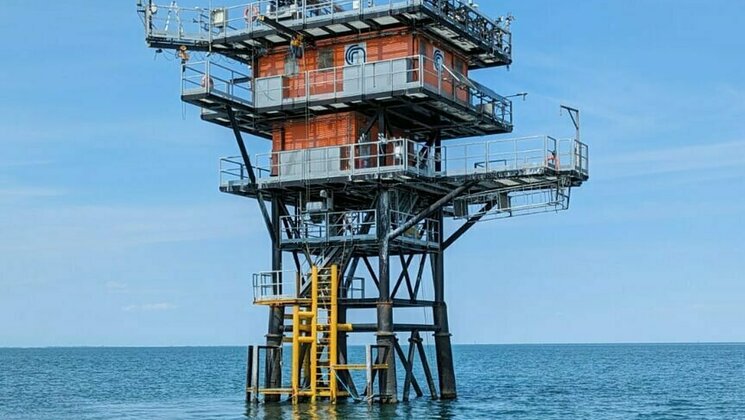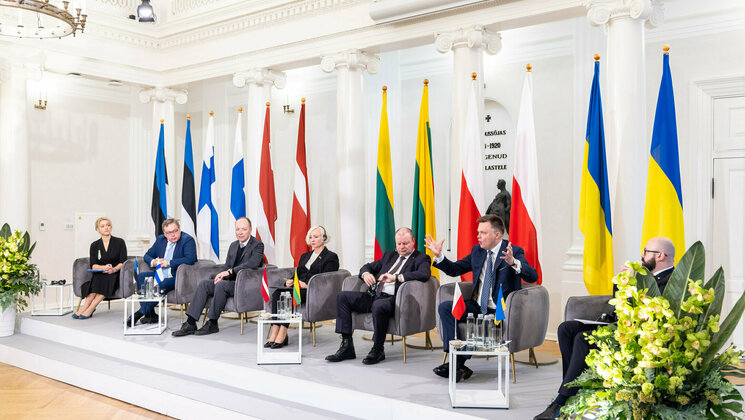-
Faculty of Arts and HumanitiesDean's Office, Faculty of Arts and HumanitiesJakobi 2 ruumid 116–121, 51005 Tartu linn, EST0Institute of History and ArchaeologyJakobi 2 51005 Tartu linn, Tartu linn, Tartumaa EST0Institute of Estonian and General LinguisticsJakobi 2, IV korrus 51005 Tartu linn, Tartu linn, Tartumaa EST0Institute of Philosophy and SemioticsJakobi 2, III korrus, ruumid 302-337 51005 Tartu linn, Tartu linn, Tartumaa EST0Institute of Cultural ResearchÜlikooli 16 51003 Tartu linn, Tartu linn, Tartumaa EST0Institute of Foreign Languages and CulturesLossi 3 51003 Tartu linn, Tartu linn, Tartumaa EST0School of Theology and Religious StudiesÜlikooli 18 50090 Tartu linn, Tartu linn, Tartumaa EST0Viljandi Culture AcademyPosti 1 71004 Viljandi linn, Viljandimaa EST0Professors emeriti, Faculty of Arts and Humanities0Associate Professors emeriti, Faculty of Arts and Humanities0Faculty of Social SciencesDean's Office, Faculty of Social SciencesLossi 36 51003 Tartu linn, Tartu linn, Tartumaa EST0Institute of EducationJakobi 5 51005 Tartu linn, Tartu linn, Tartumaa EST0Johan Skytte Institute of Political StudiesLossi 36, ruum 301 51003 Tartu linn, Tartu linn, Tartumaa EST0School of Economics and Business AdministrationNarva mnt 18 51009 Tartu linn, Tartu linn, Tartumaa EST0Institute of PsychologyNäituse 2 50409 Tartu linn, Tartu linn, Tartumaa EST0School of LawNäituse 20 - 324 50409 Tartu linn, Tartu linn, Tartumaa EST0Institute of Social StudiesLossi 36 51003 Tartu linn, Tartu linn, Tartumaa EST0Narva CollegeRaekoja plats 2 20307 Narva linn, Ida-Virumaa EST0Pärnu CollegeRingi 35 80012 Pärnu linn, Pärnu linn, Pärnumaa EST0Professors emeriti, Faculty of Social Sciences0Associate Professors emeriti, Faculty of Social Sciences0Faculty of MedicineDean's Office, Faculty of MedicineRavila 19 50411 Tartu linn, Tartu linn, Tartumaa ESTInstitute of Biomedicine and Translational MedicineBiomeedikum, Ravila 19 50411 Tartu linn, Tartu linn, Tartumaa ESTInstitute of PharmacyNooruse 1 50411 Tartu linn, Tartu linn, Tartumaa ESTInstitute of DentistryL. Puusepa 1a 50406 Tartu linn, Tartu linn, Tartumaa ESTInstitute of Clinical MedicineL. Puusepa 8 50406 Tartu linn, Tartu linn, Tartumaa ESTInstitute of Family Medicine and Public HealthRavila 19 50411 Tartu linn, Tartu linn, Tartumaa ESTInstitute of Sport Sciences and PhysiotherapyUjula 4 51008 Tartu linn, Tartu linn, Tartumaa ESTProfessors emeriti, Faculty of Medicine0Associate Professors emeriti, Faculty of Medicine0Faculty of Science and TechnologyDean's Office, Faculty of Science and TechnologyVanemuise 46 - 208 51003 Tartu linn, Tartu linn, Tartumaa ESTInstitute of Computer ScienceNarva mnt 18 51009 Tartu linn, Tartu linn, Tartumaa ESTInstitute of GenomicsRiia 23b/2 51010 Tartu linn, Tartu linn, Tartumaa ESTEstonian Marine Institute0Institute of PhysicsInstitute of ChemistryRavila 14a 50411 Tartu linn, Tartu linn, Tartumaa EST0Institute of Mathematics and StatisticsNarva mnt 18 51009 Tartu linn, Tartu linn, Tartumaa EST0Institute of Molecular and Cell BiologyRiia 23, 23b - 134 51010 Tartu linn, Tartu linn, Tartumaa ESTTartu ObservatoryObservatooriumi 1 61602 Tõravere alevik, Nõo vald, Tartumaa EST0Institute of TechnologyNooruse 1 50411 Tartu linn, Tartu linn, Tartumaa ESTInstitute of Ecology and Earth SciencesJ. Liivi tn 2 50409 Tartu linn, Tartu linn, Tartumaa ESTProfessors emeriti, Faculty of Science and Technology0Associate Professors emeriti, Faculty of Science and Technology0Institute of BioengineeringArea of Academic SecretaryHuman Resources OfficeUppsala 6, Lossi 36 51003 Tartu linn, Tartu linn, Tartumaa EST0Area of Head of FinanceFinance Office0Area of Director of AdministrationInformation Technology Office0Administrative OfficeÜlikooli 17 (III korrus) 51005 Tartu linn, Tartu linn, Tartumaa EST0Estates Office0Marketing and Communication OfficeÜlikooli 18, ruumid 102, 104, 209, 210 50090 Tartu linn, Tartu linn, Tartumaa EST0Area of RectorRector's Strategy OfficeInternal Audit OfficeArea of Vice Rector for Academic AffairsOffice of Academic AffairsUniversity of Tartu Youth AcademyUppsala 10 51003 Tartu linn, Tartu linn, Tartumaa EST0Student Union OfficeÜlikooli 18b 51005 Tartu linn, Tartu linn, Tartumaa EST0Centre for Learning and TeachingArea of Vice Rector for ResearchUniversity of Tartu LibraryW. Struve 1 50091 Tartu linn, Tartu linn, Tartumaa EST0Grant OfficeArea of Vice Rector for DevelopmentCentre for Entrepreneurship and InnovationNarva mnt 18 51009 Tartu linn, Tartu linn, Tartumaa EST0University of Tartu Natural History Museum and Botanical GardenVanemuise 46 51003 Tartu linn, Tartu linn, Tartumaa EST0International Cooperation and Protocol Office0University of Tartu MuseumLossi 25 51003 Tartu linn, Tartu linn, Tartumaa EST0
Space for @ll: a look back at the 2022 IAC

The International Astronautical Congress (IAC) is a major annual event where space people worldwide flock to meet other space enthusiasts. Government organisations, large private sector corporations, and new space companies are usually present. Tartu Observatory of the University of Tartu participated in the IAC with its largest delegation so far.
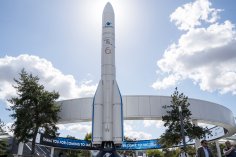
At this year's fair, an Estonian stand was set up by the joint agency of EAS and Kredex. In addition to the University of Tartu, nine other space organisations and companies were represented there. The stand's prime location allowed Estonians to get to know each other better and introduce their activities to others. There was a lot of interest in the Estonian space sector, and visitors were surprised at the wide range of space technology produced here.
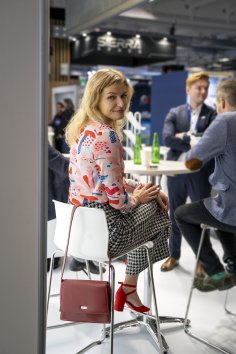
This year, the congress was held for the 73rd time, and it was hosted in Paris, France. Over five days, delegates talked about agencies' activities, the space industry's future, preserving the diversity of nature, and climate change. The last day focused on academy and science because higher education is the pillar of future technology and innovation. The congress programme provided a good overview of the progress of ongoing missions. "I looked at the congress for suitable cooperation opportunities for Tartu Observatory with other research institutions and companies, in order to channel our research and development expertise into prospective projects," said Tartu Observatory project manager Karin Pai.
The IAC is a meeting place for the space community, and a lot of effort goes into communication. At this event, many will see their existing collaborators face to face, but they will also make new contacts and meet potential collaborators.

The Tartu Observatory joint visit was supported by the European Regional Development Fund from the applied research on smart robotics funding. Therefore, it was unsurprising that given the comprehensive programme, those presentation sessions focused on applications and technology, especially robotics and rovers, were popular among Tartu Observatory researchers. It was also possible to watch the sessions online. Presentations by Hans Teras ("ULYSSES — A state of the art sandbox simulator for planetary surfaces"), Mihkel Pajusalu ("Large scale mobility on the Moon by transferring terrestrial autonomy capabilities"), and Quazi Saimoon Islam ("Lunarpoint: Interest point detector and descriptor for lunar landscapes") represented Tartu Observatory. All three presentations were on lunar exploration, which was a popular topic this year.

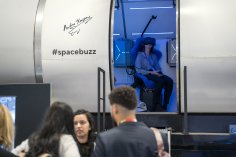
The presentation of his work and the exciting conversations that took place at the IAC had a motivating effect on space engineering PhD student Quazi Saimoon Islam: "It was fantastic to see so many young people at the conference. It reinforced the notion that the development of space tech is in good hands for years to come." According to engineer Karin Kruuse, seeing her work on the big screen in the presentations of her colleagues was incredibly exciting.
In addition to self-presentation, IAC is an excellent source of inspiration. Aditya Savio Paul, a junior scientist in space mission development, was particularly interested in visiting the relevant symposiums connected to his field of research, as well as learning about practices and approaches that concern the study of distant worlds. Many robotic exploration mission design ideas and architectures were presented, "which might also prove useful in my area of research," cheered Hans Teras, a junior researcher in space technology. For engineer Rando Avarmaa, it was great to hear that the largest space institutions, such as NASA and ESA, have become interested in model-based system engineering. "Private companies have been using model-based engineering systems instead of document-based ones for a long time. Some of our team members have found this approach applicable and useful," explained Avarmaa. Madis Kaspar Nigol, previously an engineer at Tartu Observatory, expected to see more rovers at the congress.
The Estonian joint stand was attended by the following: KappaZeta, Crystalspace, SKUDO, CybExer Technologies, Spaceit, Milrem Robotics, Guardtime, Hedgehog, Tartu Observatory of the University of Tartu, and Tallinn University of Technology.
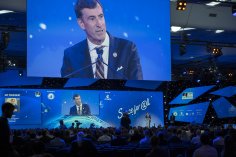
The congress was organised by the French space agency CNES, which also celebrated its 60th anniversary this year. Next year, the IAC will be held in Baku, Azerbaijan.
Read more similar news




